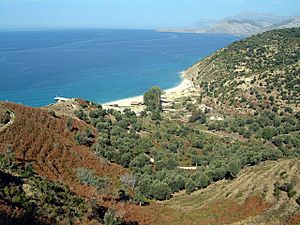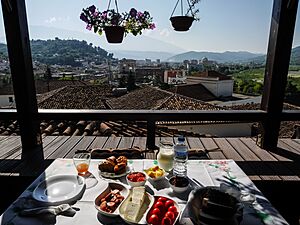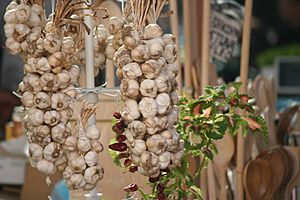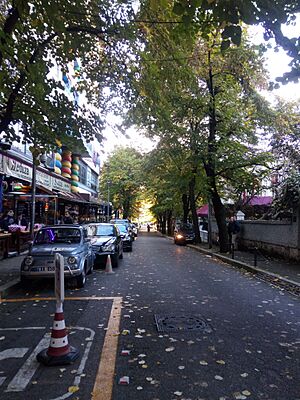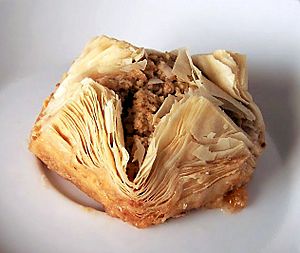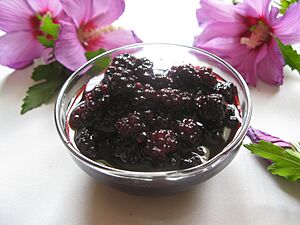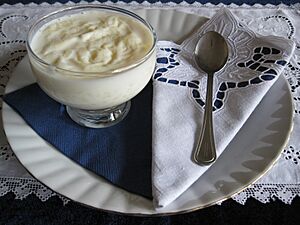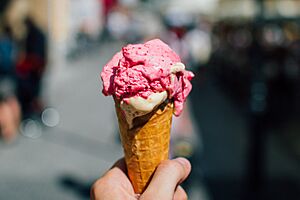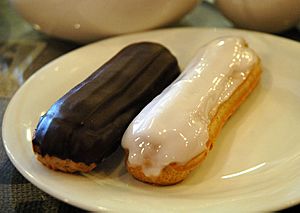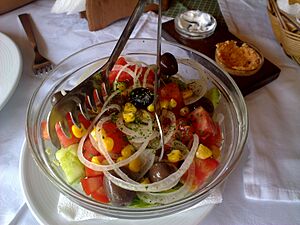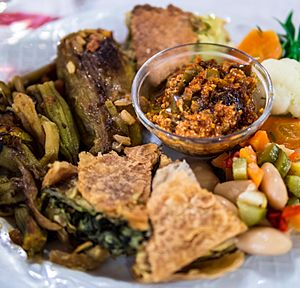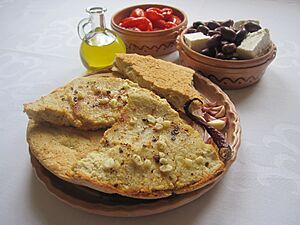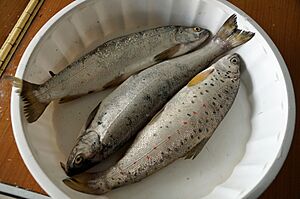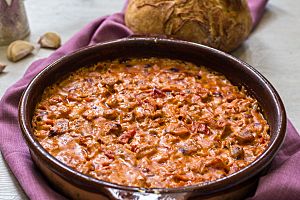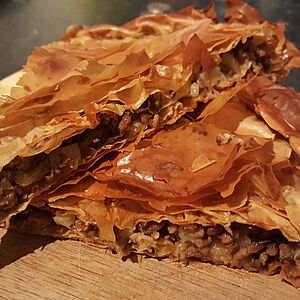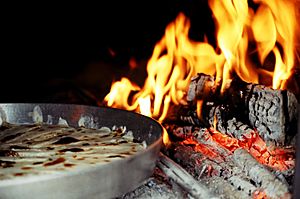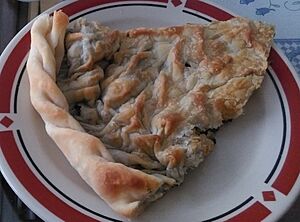Albanian cuisine facts for kids
Albanian cuisine (Albanian: kuzhina shqiptare [kuˈʒina ʃcipˈtaɾɛ]) is like the food from other Mediterranean countries. It's part of the Mediterranean diet, which means lots of olive oil, fruits, vegetables, and fish. Albania has many different cooking styles because its land is great for growing all sorts of herbs, vegetables, and fruits. Olive oil has been used in Albanian cooking for a very long time, especially near the coasts.
Being welcoming is a big part of Albanian culture. People often invite visitors to eat and drink with them. An old Albanian rule, called besa, means you should always take care of guests and strangers.
Albanian food can be split into three main regional styles:
- The northern region has food from rural, coastal, and mountainous areas. Meat, fish, and vegetables are very important here. People use ingredients like potatoes, carrots, maize, beans, cabbages, cherries, walnuts, and almonds. Garlic and onions are added to almost every dish.
- The central region also has rural, mountainous, and coastal food. This area is flat and has lots of plants and different kinds of animals. Because it's close to the sea, which has many fish, its food has a Mediterranean feel. Dishes here include many meat specialties and all kinds of desserts.
- In the south, the food uses products from farms, like dairy products, citrus fruits, and olive oil. It also uses products from the coast, like seafood. These areas are good for raising animals because there's plenty of grass and food for them.
Besides garlic, onions are probably the most used ingredient in Albania. Albania is actually ranked fourth in the world for how many onions people eat per person!
Contents
Food and Meals
Albania's location in the western Balkan Peninsula and by the Mediterranean Sea really shapes its food. Many foods common in the Mediterranean, like olives, wheat, chickpeas, dairy products, fish, fruits, and vegetables, are big in Albanian cooking. Albania has a clear Mediterranean climate. Different types of soil and land across the country allow many different foods to grow. Citrus fruits like oranges and lemons, figs, and olives grow well here.
Each region has its own typical breakfast. Breakfast is usually light. Bread is common, served with butter, cheese, jam, and yogurt. It often comes with olives, coffee, milk, tea, or raki. Trahaná (tarhana) is also a common breakfast in many rural areas. Sometimes, people just have fruit or a slice of bread with coffee or tea. Coffee and tea are enjoyed at home and in cafés.
Lunch is usually the biggest meal of the day for everyone. In the past, people went home to eat lunch with their families. Now, it's common to have lunch with friends at restaurants or cafeterias. Lunch sometimes includes gjellë, a main dish of meat cooked slowly with different vegetables. This is served with a salad of fresh vegetables like tomatoes, cucumbers, green peppers, onions, and olives. Salads usually come with meat dishes and are dressed with salt, olive oil, white vinegar, or lemon juice. Grilled or fried vegetables, sausages, and different kinds of omelettes are also eaten. Common drinks are coffee, tea, fruit juices, and milk.
Supper in Albania is a smaller meal. It often has different breads, meat, fresh fish or seafood, cheese, eggs, and various vegetables, similar to breakfast. Sometimes, people just have sandwiches.
Ingredients
Albania is in Southern Europe and close to the Mediterranean Sea. This means Albanian food uses many fresh fruits that grow naturally in its rich soil and warm sun. Albania is an agricultural country, so it imports and exports a lot of fruit. Besides citrus fruits, cherries, strawberries, blueberries, and raspberries are among the most grown fruits. Many Albanians have fruit trees in their yards. Fresh and dried fruits are eaten as snacks and desserts.
Fruits often found in Albanian cooking include apples, grapes, olives, oranges, nectarines, blackberries, cherries, persimmons, pomegranates, figs, watermelons, avocados, lemons, peaches, plums, strawberries, raspberries, mulberries, and cornelian cherries.
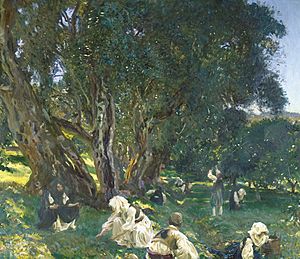
Many different vegetables are used in Albanian cooking. Because Albania has different climates and soil types, you can find many kinds of cabbages, turnips, beetroots, beans, potatoes, leeks, and mushrooms. Dried or pickled vegetables are also used, especially in drier or colder areas like the Albanian Alps, where fresh vegetables were hard to get out of season. Commonly used vegetables include onions, garlic, tomatoes, cucumbers, carrots, peppers, spinach, lettuce, grape leaves, beans, eggplants, and zucchini.
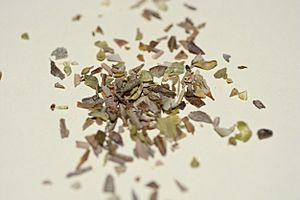
Herbs are very popular. You can easily find many kinds in supermarkets or local markets. Being close to the Mediterranean Sea and having good weather allows about 250 aromatic and medicinal plants to grow. Albania is one of the top producers and exporters of herbs in the world. The country is also a big producer of oregano, thyme, sage, salvia, rosemary, and yellow gentian. The most common herbs and seasonings in Albanian cooking include artichoke, basil, chili pepper, cinnamon, coriander, lavender, oregano, peppermint, rosemary, thyme, bay leaf, vanilla, and saffron.
Drinks
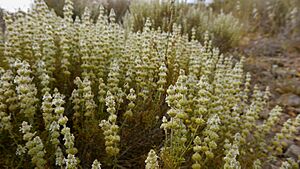
Tea is a widely enjoyed drink in Albania, served in cafés, restaurants, or at home. The country grows many different herbs. The most popular teas in Albania include Albanian-style mountain tea, which grows in the mountains and villages, and Russian- and Turkish-style black tea with sugar, lemon, milk, or honey.
Coffee is another popular drink, especially in cities and villages. Many types of coffee are popular, including filter coffee and instant coffee like espresso, cappuccino, macchiato, mocha, and latte. Cafés are everywhere in cities and are used for meeting friends and doing business. Almost all cafés serve baked goods and sandwiches, and many also serve light meals. Tirana is especially known for its café culture.
In 2016, Albania had more coffee houses per person than any other country in the world, even Spain! There are 654 coffee houses for every 100,000 people in Albania, a country with only 2.5 million residents.
Dhallë is a traditional and healthy yogurt-based drink. It's made by mixing yogurt with water or milk and spices. It's very popular in summer and can be served with salt.
Boza is a malt drink made from maize (corn) and wheat. It's often enjoyed with desserts in Albania.
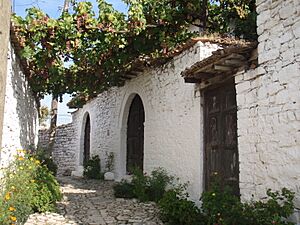
Raki is the most popular strong drink in Albania and is considered the national spirit. The most common types of raki are made from grape, plum, or blackberry. It's often served to older people and can be heated and sweetened with honey or sugar, with added spices. In the south, Raki rigoni, made from white oregano, is very popular.
Albania is a country where people traditionally drink wine. Albanians drink wine in moderation, almost always with meals or at social events. Even though Islam is the main religion in Albania and many Muslims avoid alcohol, wine is available. Albanians drink about 5.83 liters of wine per person each year, and this amount is growing as Albania produces more high-quality wine. Wine production in Albania goes back 6,000 years, making Albania one of the earliest wine producers in Europe.
Pastries and Desserts
Home baking is a strong tradition in Albania, and pâtisseries (pastry shops) are found in every city and village. Albanian desserts and pastries mostly use fruits like oranges and lemons that grow in the country. Traditionally, fresh fruits are often eaten after a meal as a dessert. These dishes are inspired by both Western and Eastern cultures.
Kanojët is a typical Sicilian pastry. It's very common among the Arbëreshë people, who brought this dish back to their homeland, Albania, where it is popular. It's made of tube-shaped fried pastry dough, filled with a sweet, creamy filling usually containing ricotta cheese. The kanojët from Piana degli Albanesi, an Arbëreshë village, are often said to be the best.
Baklava is often made in Albania, especially around certain religious holidays for Muslims, Catholics, and Orthodox Christians. It's prepared on large trays and cut into different shapes. Baklava is made with hazelnuts or walnuts and sweetened with syrup.
Petulla is a traditional fried dough made from wheat or buckwheat flour. It's a popular dish among Albanians and is served with powdered sugar or feta cheese and raspberry jam.
Pandispanjë is a traditional base for several Albanian desserts and cakes. It's made from flour, sugar, butter, and eggs. Various fillings are used, such as jelly, chocolate, fruit, and pastry cream.
Fruit jam, also called Reçel, is enjoyed all year in Albania and is a big part of Albanian cooking. Fruit preserve is made by cooking the juice of the fruit, or the fruit itself (which usually grows in Albania), with sugar. It's served as a side dish with many meals.
Zupa is a popular dessert made by layering cookies or sponge cake with pastry cream. Another similar dessert is an Albanian custard called krem karamele, very much like crème brûlée. This dessert is made with milk, cream, egg yolks, sugar, vanilla, and flavored with orange or lemon zest and cinnamon.
Different kinds of hallvë are prepared across the country. Some common types are flour halva, home-cooked semolina halva, and shop-made sesame halva. It's a typical sweet at local religious fairs in Albania.
Tambëloriz, also known as sultjash, is a popular sweet among Albanians worldwide. It's a type of rice pudding made from milk, rice, and cinnamon. Nuts and raisins can also be added.
Tollumba is a fried, crispy, and sweet dessert traditionally eaten in the Balkan Peninsula. It's made of fried dough pieces, similar to doughnuts, soaked in lemony syrup. The dough contains starch and semolina, which keeps it light and crispy.
Akullore is the Albanian word for ice cream, and it's enjoyed in both summer and winter. Ice cream is a popular dessert after a meal. You can find it in restaurants, pastry shops, and bars all over Albania.
Kadaif is a pastry made from long, thin noodle threads. It's filled with walnuts or pistachios and sweetened with syrup. It's sometimes served with baklava.
Kabuni is a traditional cold Albanian dessert. It's made of rice fried in butter, mutton broth, raisins, salt, and caramelized sugar. It's then boiled before sugar, cinnamon, and ground cloves are added.
Pastashu is made from choux pastry, filled with cream, vanilla, coffee, or chocolate-flavored custard. It's usually topped with fondant icing. This dessert is known as Éclair in France and Bignè in Italy.
Trileçe is an Albanian version of the Spanish Tres leches cake. It's a sponge cake made with three milks, usually cow's milk and cream. It's believed that Albania was the first country to bring this dessert from South America to the area. Its popularity might have grown because of Brazilian soap operas in Albania, leading local chefs to figure out how to make it. Then, it spread to Turkey.
Ashure, one of the world's oldest desserts, is served especially during Muslim (Bektashi) holidays in Albania. It's a porridge made from a mix of grains, nuts, and dried fruits.
Homemade panettone, an Italian sweet bread, is usually prepared and enjoyed for Christmas and New Year in Albania.
Lokum is a Turkish candy eaten in Albania.
Appetizers and Salads
Popular appetizers in Albania include wheat bread or cornbread. Bread is one of the most important foods and is always on the Albanian table. That's why the saying for 'going to eat a meal' (Template:Albanian language: për të ngrënë bukë) literally means 'going to eat bread'. In Albania, bread is also part of the traditional Albanian welcome saying: "bread, salt and heart" (bukë, kripë e zemër).
Vegetable salads are almost always served with both lunch and dinner, especially with meat dishes. The ingredients always used in salads are green or red peppers, onions, tomatoes, olives, and cucumbers. Albanian salads are dressed with salt, olive oil, or lemon and vinegar. Common dressings use garlic, lemon, and black pepper.
An Albanian-style meze is a mix of fresh and cooked vegetable salads, pickled cucumbers and other vegetables, hard-boiled eggs, prosciutto ham, salami, and feta cheese. It's served with roasted bell peppers, olive oil, and garlic at special meals and in restaurants. Today, modern Albanian meze dishes mix traditional and new appetizers.
Fërgesë verorë (summer fërgesë) is the vegetarian version of fërgesë, a national dish in Albania. It's made of green and red peppers, peeled tomatoes, and onions. It's often served as a side dish with various meat dishes.
Japrak is a stuffed vegetable dish made with grape leaves, olive oil, and filled with rice, grilled beef, and chopped onions. It's usually served cold with bread and tarator.
Tarator is a cold appetizer, usually served cold as a side dish during hot summer months. The ingredients of tarator include cucumber, garlic, olive oil, salt, and yogurt. Fried and grilled vegetables and seafood are often served with tarator.
Large white kidney beans (fasulle plaqi) are a typical appetizer or side dish. They are baked in an earthen pot with tomatoes, onions, peppermint, oregano, bay leaves, and black pepper.
Many different soups are enjoyed, especially in winter. Popular soups include potato, cabbage, bean, and fish soups. Trahana is a popular soup in the Eastern Mediterranean. It's made from a fermented mix of wheat and fermented milk. Other dishes include Groshët and Shqeto, which come from the Lunxheri region of Gjirokastër.
Other dishes include mëlci pule (chicken liver), eggplant appetizers, panaret (famous among Arbëreshës), stuffed peppers (green peppers filled with rice, meat, other vegetables, and herbs), turshi lakre, fried sardele me Limon, papare (bread leftovers cooked with water, egg, butter, and Gjizë (salted curd cheese)), and bread and cheese, called Bukë me djathë.
Meat and Fish
Albanian food uses a lot of meat. Beef and veal are the most eaten meats, followed by pork. Albania has many small restaurants that specialize in beef, lamb, goat, and veal. In high mountain areas, smoked meat and pickled foods are common. Even animal organs like intestines and heads are used in dishes and are seen as special treats.
The most common poultry eaten is chicken and duck. Chicken is prepared in many ways, from simple oven roasting to fancy casseroles with rich sauces.
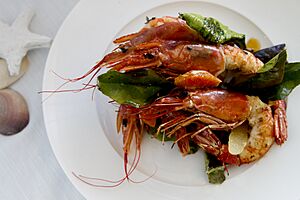
Fresh fish is easy to find, caught off the coasts of the Adriatic Sea and Ionian Sea (part of the Mediterranean Sea). Fish also comes from lakes like Lake Butrint, Lake Shkodër, Lake Ohrid, and Lake Prespa, as well as lagoons like Karavasta Lagoon, Narta Lagoon, and Patos Lagoon. Fresh fish is served whole, Mediterranean style, grilled, boiled, or fried whole or in slices. It's dressed only with fresh lemon juice. Fish dishes are often flavored with white vinegar and virgin olive oil, which grows especially well in Southern Albania.
Albanians living in coastal cities like Durrës, Sarandë, and Vlorë love their seafood specialties. Popular seafood dishes include trout, calamari, octopus, cuttlefish, red mullet, sea bass, gilt-head bream, and more. Baked whiting, carp, mullet, or eel with olive oil and garlic are also widely eaten.
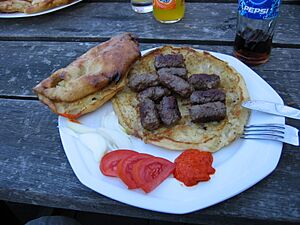
Fërgesë is a very famous dish from Tirana and Central Albania. It's made of peppers, tomatoes, onions, and gjizë (a type of cottage cheese, thicker than ricotta). The ingredients are cooked on the stove and then in the oven to make a thick sauce. Some versions include liver or cooked beef. Fërgesë with liver is seen as more traditional in Tirana and is sometimes just called fërgesë tirane.
Tavë Kosi is a national dish in Albania that everyone loves. This special dish is simply baked lamb and rice, served with a flavored yogurt sauce. Recently, it has become very popular in Greece and Turkey because many Albanians live there.
Qebapa are small, homemade grilled meat sausages without skin, made from a mix of lamb and beef. They are usually served with onions, sour cream, ajvar, and pita bread called pitalka.
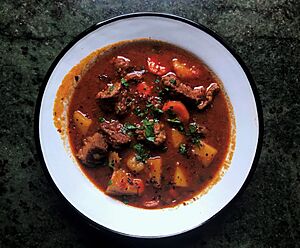
Gullash, or tasqebap, is eaten very often in the mountainous areas of Albania. It's a traditional meat stew spiced with paprika, originally from Hungary, and popular across Central Europe and the Balkans.
Gjel deti me përshesh (turkey with përshesh) is the usual New Year's dish in many Albanian families and is also eaten at other celebrations. The turkey is first boiled and then roasted. It's served with përshesh, which is made by baking pieces of kulaç (a type of bread) with turkey broth, along with mint and other spices.
Paçe is a traditional Albanian dish. It's made with a sheep's, pig's, or any cattle's head, boiled until the meat easily comes off. Then it's stewed with garlic, onion, black pepper, and vinegar. Sometimes a little flour is added to make the stew thicker. It's a hot and hearty winter stew.
Proshute is a term used in Albania for many types of salami and ham that have been seasoned, cured, and air-dried. It's served for breakfast or lunch as an appetizer. Dishes with proshute include omelete me proshute dhe djathe (omelette with ham and cheese), role buke me proshute (bread roll with ham), and sallate orizi me pjeper dhe proshute (rice salad with melon and ham).
Qofte are fried meatballs usually made of minced meat, herbs, and spices. They are cooked with tomato sauce and vegetables or beans. All over the country, there are special shops called qofteri that offer qofte and beer.
Mimilige is made from cornmeal boiled in water with lamb intestines, butter, cheese, and corn flour. This warm dish can be baked, grilled, fried, or served creamy. It's a very important dish in the Labëria region.
Pies
Albanian pies are some of the most special and well-known dishes in traditional cooking. They can be either sweet or savory. So, a piece of pie can easily be the main dish of a meal.
Pite is considered one of Albania's national foods. Several famous musicians of Albanian heritage like Rita Ora, Dua Lipa, and Action Bronson have shared their love for this Albanian dish.
It's often served hot and fresh with pickled vegetables, honey, yogurt, or fruit jam. Today, flia is mainly served at large social gatherings, weddings, births, and other events. Fli is a dish mostly cooked in Kosovo. It's important to know that dishes can be different depending on the region of Albania. Bakllasarëm is a layered pie, also known as pite, but without any filling. It's covered with yogurt and garlic and then heated again. It's especially eaten for lunch. Another popular dish is Kungullur, which is made of filo pastry layers filled with mashed pumpkin, butter, salt, or sugar.
Well-known pies include Byrek, Pepeq, Shaprak, Qollopita, or Lakror. Lakror is a pie with thinner dough layers than a byrek. It's traditionally cooked on hot coals, covered with a metal dome-shaped lid. Common fillings are leek and gjizë (a type of cheese) or tomato and onion. It's a specialty of Southern Albanian regions, like Lunxheri or Korçë.
See also
 In Spanish: Gastronomía de Albania para niños
In Spanish: Gastronomía de Albania para niños


